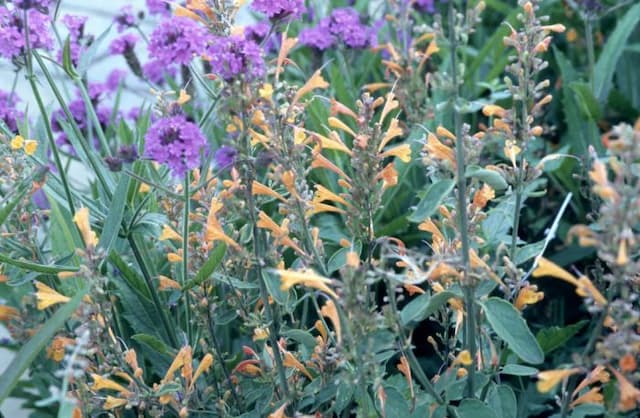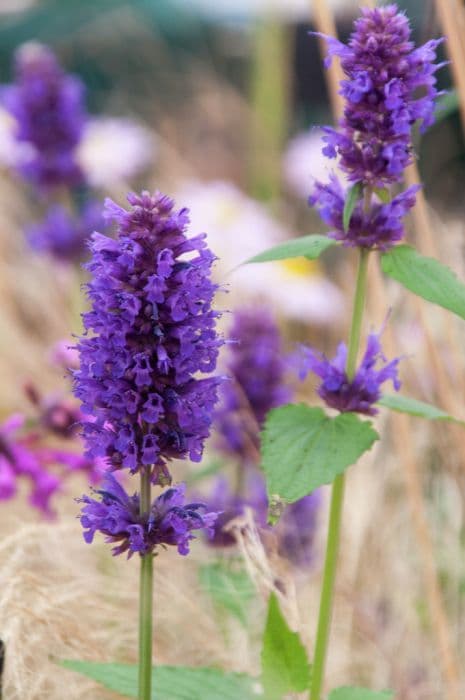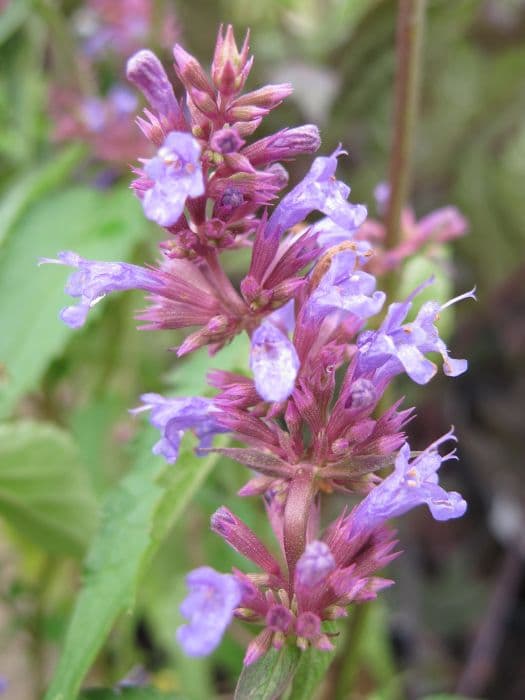Catmint Nepeta racemosa Rcbam3

ABOUT
Nepeta racemosa Rcbam3, more commonly known as catmint, is a perennial plant renowned for its ornamental appeal and allure for cats. The plant exhibits a robust growth habit with a profusion of leaves and stems that create a bushy appearance. The foliage is typically soft to the touch, stemming from a central point and splaying outwards in various directions. The leaves of catmint are often small, with a heart-shaped or oval outline, and possess a grayish-green hue. They are known for their distinctive, slightly serrated edges and the fine downy texture that covers both the top and underside. Moreover, catmint is particularly cherished for its splendorous flowering spectacle. The small flowers cluster along spikes, blooming with a remarkable bluish-purple coloration that adds a touch of vibrancy to the green backdrop of the foliage. These flowers usually blossom in whorls around the spike, shaping a loose and informal, yet strikingly attractive, floriferous display. They exude a subtle, enchanting fragrance that tends to attract a variety of pollinators, including bees and butterflies. While this description does not go into detail about the size of Nepeta racemosa Rcbam3, it's important to note that the habit of growth and spread of the blooms contribute significantly to the visual impact of the plant in a garden setting. The harmonious blend of aromatic foliage and eye-catching flowers makes catmint a popular choice among gardeners seeking to create a sensory and wildlife-friendly garden space.
About this plant
 Names
NamesFamily
Lamiaceae.
Synonyms
Dwarf Catmint, Raceme Catnip, Persian Catmint, Little Titch Catmint.
Common names
Nepeta mussinii, Nepeta mussini, Nepeta racemosa var. racemosa, Glechoma racemosa, Nepeta racemosa.
 Toxicity
ToxicityTo humans
Nepeta racemosa, commonly known as catmint, is generally not considered toxic to humans. There are no significant reports of poisoning in humans from consuming catmint. It is commonly used in gardens for its aromatic leaves and as a herbal remedy in moderation.
To pets
Catmint is not considered toxic to pets. In fact, it is known for its behavioral effects on cats, which may roll in or chew the plant due to the presence of nepetalactone. However, excessive ingestion could potentially cause mild gastrointestinal upsets such as vomiting or diarrhea in some animals.
 Characteristics
CharacteristicsLife cycle
Perennials
Foliage type
Deciduous
Color of leaves
Green
Flower color
Blue
Height
1-2 feet (30-60 cm)
Spread
1-2 feet (30-60 cm)
Plant type
Herb
Hardiness zones
3-8
Native area
Europe
Benefits
 General Benefits
General Benefits- Ornamental Value: Nepeta racemosa, commonly known as Catmint or Dwarf Catnip, adds aesthetic appeal to gardens with its lavender-blue flowers and gray-green foliage.
- Attracts Pollinators: The plant is known for attracting bees, butterflies, and other beneficial insects which are vital for pollination in the garden ecosystem.
- Drought Tolerance: Catmint is drought-resistant once established, making it suitable for xeriscaping or gardens in arid climates.
- Low Maintenance: It is easy to care for, requiring minimal maintenance, which is ideal for gardeners of all skill levels.
- Fragrance: The foliage and flowers emit a pleasant fragrance that can enhance the sensory experience of a garden space.
- Deer and Rabbit Resistance: Catmint is not a favorite of deer or rabbits, making it a good choice for gardens troubled by these animals.
- Border Planting: Due to its compact size, it is well-suited for borders, edges, and rock gardens, helping to define garden spaces.
- Companion Planting: Catmint works well planted alongside roses and vegetables as it can help deter certain pests.
- Ground Cover: In large plantings, it can provide an effective ground cover, reducing weed growth and soil erosion.
- Long Blooming: The plant has a lengthy blooming period from late spring to early autumn, ensuring color in the garden for an extended time.
 Medical Properties
Medical Properties- Anti-inflammatory: Nepeta racemosa contains compounds that may reduce inflammation.
- Antispasmodic: It may help relax muscle spasms and relieve cramps.
- Diuretic: Traditionally used to increase the flow of urine and reduce fluid retention.
- Sedative: Sometimes used for its mild sedative effects to help with anxiety and sleep disorders.
- Antimicrobial: The plant may have antimicrobial properties that could help fight certain bacteria or fungi.
- Carminative: It may help ease gas and bloating in the digestive system.
 Air-purifying Qualities
Air-purifying QualitiesThis plant is not specifically known for air purifying qualities.
 Other Uses
Other Uses- Nepeta racemosa, commonly known as catmint, can be used as a natural insect repellent when its leaves are crushed and the oils are released, deterring various insects from the area.
- The plant is sometimes incorporated into landscape design for erosion control due to its ability to grow in poor soils and to spread via rhizomes, stabilizing the ground.
- Catmint can be used in companion planting to attract beneficial insects such as bees and butterflies, enhancing pollination in the garden.
- Its aromatic foliage is sometimes used in potpourris to impart a pleasant smell to rooms and closets.
- Artists and crafters may use the delicate flowers and leaves of catmint in pressed flower projects and to create natural dyes for fabrics.
- Gardeners may plant catmint as a border plant to create natural, soft edges along pathways or flower beds.
- Catmint plants can serve as an organic mulch as they decompose, adding nutrients back into the soil and improving its structure.
- The dried leaves of catmint can be used in sachets to deter pests from closets and drawers in a manner similar to lavender.
- Some chefs use small amounts of catmint flowers to add a unique flavor to certain dishes, though it is not a common culinary herb like related mint species.
- In ecological restoration projects, catmint may be planted to provide a quick-cover groundcover, helping to outcompete invasive weeds.
Interesting Facts
 Feng Shui
Feng ShuiThe Catmint is not used in Feng Shui practice.
 Zodiac Sign Compitability
Zodiac Sign CompitabilityThe Catmint is not used in astrology practice.
 Plant Symbolism
Plant Symbolism- Relaxation: Commonly known as Catmint, Nepeta racemosa is often associated with its calming effect, not just on felines, but also in humans as an herbal remedy to soothe nerves.
- Playfulness: Catmint can symbolize fun and playfulness due to its well-known ability to make cats exhibit playful behavior after interaction with the plant.
- Affection: As cats are drawn to Catmint and often rub against it with apparent affection, the plant can represent love and the pleasure of companionship.
- Attractiveness: Catmint can symbolize attraction, as it is irresistible to cats, and similarly, it can imply the allure one person feels towards another.
 Water
WaterThe Catmint, commonly known as Nepeta racemosa 'Walker's Low', prefers consistent moisture but well-drained soil, meaning it should be watered when the top inch of soil feels dry. In general, this might mean watering once every week with approximately 1 gallon of water, although this can vary depending on climate conditions and soil type. During hot, dry spells, more frequent watering may be necessary, whereas in cooler, wetter conditions, less watering is required. It's important to avoid overwatering which could lead to root rot, so ensure the soil is draining properly.
 Light
LightCatmint thrives in full sun to partial shade, indicating that it requires at least 6 hours of direct sunlight daily for optimal growth. The best spot for this plant would be a sunny border or an area that receives morning sunlight and dappled shade in the afternoon. Avoid deep shady areas, as this can reduce flowering and make the plant leggy.
 Temperature
TemperatureCatmint is hardy and can tolerate a range of temperatures, but the ideal growing conditions are between 60°F and 70°F. It can survive minimum temperatures down to around -30°F, making it suitable for USDA hardiness zones 4 through 8. Avoid exposing the plant to prolonged periods of heat above 90°F, as this could cause stress to the plant.
 Pruning
PruningPruning Catmint helps maintain its shape, encourages denser growth, and can promote a second bloom in the same season. Prune lightly in early spring to shape the plant and then again after the first flush of flowers fades, generally by cutting the plant back by one-third to one-half. The best times for pruning are early spring and midsummer, after the initial flowering.
 Cleaning
CleaningAs needed
 Soil
SoilCatmint (the common name for Nepeta racemosa) thrives in well-draining, loamy or sandy soil with a pH range between 6.0 and 7.5. A simple soil mix recipe for catmint would include equal parts of garden soil, coarse sand, and compost to ensure proper drainage and fertility.
 Repotting
RepottingCatmint should be repotted every two to three years to refresh the soil and prevent root crowding. It's best to repot in the spring before new growth starts.
 Humidity & Misting
Humidity & MistingCatmint prefers average to dry humidity conditions and will thrive in the typical humidity levels found outdoors. Indoors, it doesn't require any special humidity adjustments, making it quite a hardy plant in various environments.
 Suitable locations
Suitable locationsIndoor
Grow catmint in a sunny spot with well-draining soil.
Outdoor
Plant catmint in full sun to partial shade in fertile soil.
Hardiness zone
3-8 USDA
 Life cycle
Life cycleNepeta racemosa Rcbam3, commonly known as the Dwarf Catmint, begins its life cycle as a seed sown in well-draining soil in early spring or fall. Upon germination, the seedling emerges, developing true leaves and a root system, and over time forms a vegetative clump of grey-green foliage. As the plant matures, it enters the flowering stage during late spring to early summer, producing small, lavender-blue flowers in racemes that are attractive to bees and butterflies. After pollination, the flowers develop into seed heads and, if the conditions are favorable, the seeds disperse and can give rise to new plants. In the perennial phase, the Dwarf Catmint can survive through winter by dying back to the ground level and entering dormancy. With the arrival of warmer temperatures in spring, the plant breaks dormancy, regrows from its rootstock, and the cycle repeats.
 Propogation
PropogationPropogation time
Spring to early summer
Propogation: The most popular method of propagating Catmint (Nepeta racemosa Rcbam3) is through division, which can be done in either spring or early fall. This involves carefully digging up the established plant and gently separating it into smaller sections, ensuring each one has a portion of the root system. Once divided, the new sections can be replanted into a well-draining soil mix, spacing them about 15 to 18 inches apart (approximately 38 to 45 centimeters). It's essential to water the new plants thoroughly after planting to help establish them. Catmint is a robust plant that will generally take well to this method, thriving once it acclimates to its new location.







![Bugle [Black Scallop]](/_next/image?url=https%3A%2F%2Fplants-admin.emdemapps.com%2Fimages%2Fplants%2F%2Fimages%2F604b624330cd1.png&w=640&q=75)

